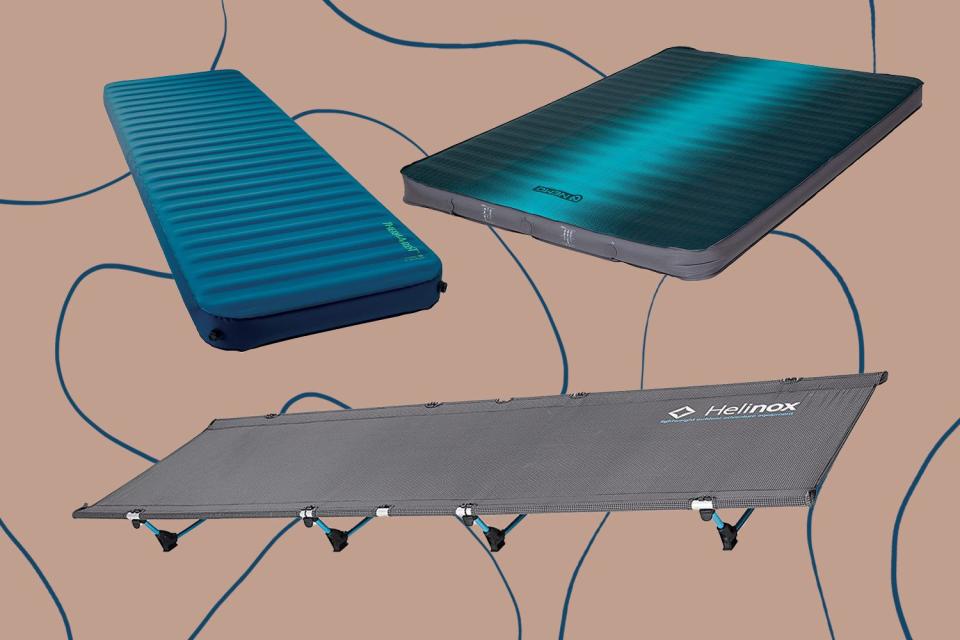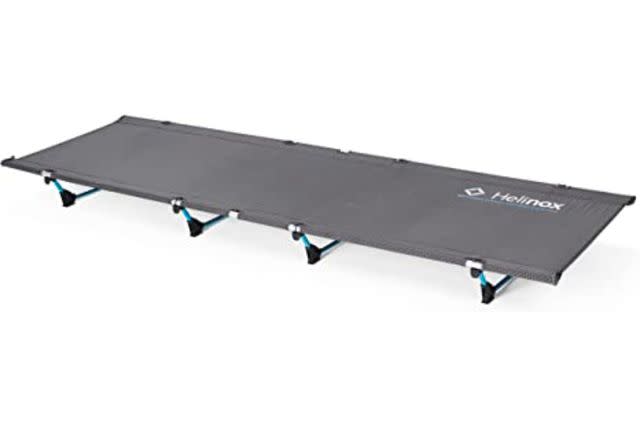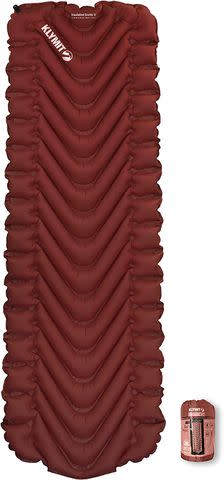The 8 Best Sleeping Pads of 2023
Dotdash Meredith and Yahoo Inc. may earn commission or revenue on some items through the links below.
Therm-a-Rest’s exceptionally comfortable MondoKing 3D earned our top pick.

Amazon
Good sleeping pads provide cushion against the rocks or tree roots you may accidentally pitch your tent on. They also keep you insulated, which is crucial when temperatures drop at night. We've all experienced a time in which you arrive at your campsite so late that you only have enough energy to quickly assemble a tent and climb inside your sleeping bag before passing out. In the morning, you inevitably can't feel or move parts of your body, which doesn't make for a pleasant start to your day. A quality sleeping pad can not only prevent the aches and pains that come with tent camping, but also can help keep you warm throughout the night.
But how do you find a good sleeping pad for your trip? If you are car camping and don’t mind size and weight, choose a thick air pad, inflatable air-construction mattress, or self-inflating open-cell foam pad, like our favorite sleeping pad, the Therm-a-Rest MondoKing 3D. If you are backpacking, then weight and how quickly you can set up your pad become vital. Look at ultra-light air pads or light-weight self-inflating pads. If you don’t want to mess with inflating a pad, then stick to a closed-cell foam pad.
Therm-a-Rest MondoKing 3D Camping Sleeping Pad
Best Overall

Why We Love It: It’s well worth the weight and size for camping and is even great for at-home use as a guest mattress.
What to Consider: This pad self-inflates but not all the way — the pump sack method is a chore, so you’ll definitely want a rechargeable air pump.
The Therm-a-Rest sleeping pad delivers high quality and support that the whole family will fight over. The latest MondoKing 3D is about a quarter the size of its predecessor and half the size of the earlier MondoKing 3D, but still packed with the comfort you want for a good night's sleep while camping.
Therm-a-Rest invested a lot of technology into making their most comfortable pad lightweight and compressible. It still boasts a 4.2-inch thickness when inflated and can compress down to 26 x 10.3 inches (31 x 10.3 inches in the earlier version of the MondoKing) because of the StrataCore construction. The stretch-knit fabric feels like satin against your skin, and Therm-a-Rest’s TwinLock system offers a dedicated one-way inflation valve marked clearly “in,” and a dedicated deflation valve marked “out.” The MondoKing 3D comes in two sizes, large and XX large.
Price at time of publish: $240 for large
Packed dimensions: 10.3 x 26 inches (large) | Dimensions: 77 x 25 x 4.2 inches (large) | Weight: 4.4 pounds (large) | Insulation type: Open-cell foam | R-value: 7
Nemo Equipment Roamer Sleeping Pad
Best Double

Why We Love It: There's a matching sleeping bag available for this sleeping pad, and they can be locked together for an extra-stable night.
What to Consider: It takes some time to deflate this pad and wrestle it back into its stuff sack.
Designed to pair with the Jazz Dou sleeping bag, Nemo Equipment’s Roamer is a self-inflatable open-cell foam sleeping pad. It can inflate up to 4 inches in height. Nemo Equipment sped up inflation and deflation with their innovative proprietary internal air channels. The Jazz Double sleeping bag comes with a pocket designed to fit the Roamer. Once they're attached, you won’t feel the rocks and uneven landscape beneath your tent—no matter how much you goof off. When you’re ready to pack up, just deflate the pad without removing it from the sleeve, roll up everything at once, and stuff it into the Jazz duffel bag.
Price at time of publish: $400
Packed dimensions: 11 x 26 inches | Dimensions: 78 x 52 x 4 inches | Weight: 7.5 pounds | Insulation type: Open-cell foam | R-value: 6
Big Agnes Twister Cane Biofoam Pad
Best Budget

Why We Love It: It’s durable and easy to use, and there’s no inflation required.
What to Consider: It’s not as comfortable as inflated open-cell foam pads.
Because closed-cell foam pads are waterproof and quick to utilize, they're great to quickly toss on the ground while you're making camp. Made of more than 60 percent sustainably grown sugarcane resin, Big Agnes’ Twister Cane Biofoam Pad is a great choice if you want to go the closed-cell route. The lightweight pad has a smooth top side and a tire-tread pattern bottom to generate warmth, and its production process actually helps remove carbon from the environment.
Price at time of publish: $50
Packed dimensions: 7 x 20 inches | Dimensions: 7 x 20 inches | Weight: .8 pounds | Insulation type: Closed-cell foam | R-value: 1.7
Related:The Best Camping Air Mattresses, According to Our Tests
Helinox Lite Camp Cot
Best for Cold Weather

Why We Love it: This cot not only packs as small and light as most sleeping pads on the market, it also keeps you off the ground.
What to Consider: The tension lock handles require a steep learning curve.
In the winter, doubling up on sleeping pads will keep you warm. A closed-cell foam pad beneath an air mattress or self-inflatable pad works well. Alternatively, if there’s snow on the ground, you might consider a cot. The Helinox Lite Camp is about five inches off the ground. Since 2009, I haven’t been able to find another brand that can challenge Helinox’s claim to designing the world’s lightest, strongest, and most comfortable portable furniture. Because of a proprietary aluminum alloy, which offers maximum strength with minimum weight, it takes just about the same amount of time to set up a Helinox cot as an inflatable pad. It also packs up nearly the same size and weight as a sleeping pad.
Price at time of publish: $300
Packed dimensions: 5 x 5 x 21 inches | Dimensions: 73 x 23.5 x 5 inches | Weight: 2.8 pounds | Insulation type: None | R-value: N/A
Therm-a-Rest RidgeRest Classic
Best for Kids

Why We Love it: The high degree of friction will keep kids from sliding off.
What to Consider: It may not be as soft as an air mattress or self-inflatable pad.
Even after a long day of camping, some kids can be so active at bedtime that their sleeping setup ends up woefully askew. To keep them from sliding off their sleeping pads, use closed-cell foam pads that have a lot of texture, thus creating a great deal of friction and making it harder for your child to slip off. Therm-a-Rest’s RidgeRest Classic is a great option. The durable crosslink foam is covered in ridges that help trap heat in addition to keeping sleeping bags in place. It’s also on the more affordable side when it comes to sleeping pads and comes with a lifetime warranty.
Price at time of publish: $32
Packed dimensions: 6.5 x 20 inches | Dimensions: 20 x 72 x .6 inches | Weight: .9 pounds | Insulation type: Closed-cell foam | R-value: 2
REI Trailgate Vehicle Sleeping Platform
Best for Vehicle-supported Camping

Why We Love it: You can swap the legs and adjust to fit a wide range of vehicles.
What to Consider: It’s too heavy for many people to carry on their own, and the pad is not very comfortable.
In July 2022, REI launched their Trailgate Vehicle collection in response to the increased number of people outfitting their mid-sized vehicles for camping. The Sleeping Platform can be partially set up to a 25-inch width to preserve trunk and backseat space, or you can expand it to 40 inches for more sleeping room. It has three sets of adjustable legs to create a level surface and accommodate a range of vehicles. The front legs adjust between 20 and 27 inches, while the rear legs can be set between 7 and 10 inches.
Price at time of publish: $300 for 25-inch
Packed dimensions: 31.5 x 19 x 13 inches | Dimensions: 72 x 25 x 10.7 inches | Weight: .9 pounds | Insulation type: Closed-cell foam | R-value: 1.7
Related:The 12 Best Sleeping Bags of 2023, Tested and Reviewed
Sea to Summit Ether Light XT Insulated Air Sleeping Pad
Best for Side Sleepers

Why We Love it: This soft pad is four-inches thick.
What to Consider: It may leak air throughout the night.
This mummy-style sleeping pad uses two types of insulation to keep you warm and cozy throughout three-seasons of camping. The four inches of plush Ether Light XT Air Sprung Cells and Exkin Platinum insulation are sure to keep even the most restless campers comfortable. The pad also includes a multifunction valve and Airstream Pump that makes the inflation and deflation process quick and easy. With three sizes to choose from and a PillowLock section to prevent pillows from slipping when you move from side to side, this pad will improve sleep quality for any camper.
Price at time of publish: $199 for regular size
Packed dimensions: 9.5 x 4.5 inches | Dimensions: 72 x 21.5 x 4 inches | Weight: 1.1 pounds | Insulation type: Synthetic | R-value: 3.2
Klymit Insulated Static V Inflatable Sleeping Pad
Best for Backpacking

Why We Love it: It comes with an easy-to-pack stuff sack.
What to Consider: While it's insulated, thicker pads will keep you warmer.
When hiking to your campsite (or sites), it's important to make sure your gear is easily portable without sacrificing quality. This sleeping pad from Klymit provides the perfect amount of insulation and support without adding bulk to your pack. At just about 1 pound in weight, this polyester pad easily rolls up into a stuff sack that can be attached to the outside of your backpack or slipped inside. Its twist-pull valve is also designed for rapid inflation — fully expanding in just ten breaths — so you're ready for sleep without exerting extra effort.
Price at time of publish: $69
Packed dimensions: 5 x 8 inches | Dimensions: 72 x 23 x 2.5 inches | Weight: 1 pounds | Insulation type: Synthetic | R-value: 4.4
Tips for Buying a Sleeping Pad
Make sure a sleeping pad is the right move for you
Before shopping for a sleeping pad, decide whether you want to sleep on or off the ground. Nowadays, companies like Helinox make cots that are sometimes even lighter than sleeping pads. If some space between you and the ground is more important to you than, say, a plush sleeping surface, consider opting for a lightweight cot instead of a sleeping pad. If you have the packing space for it, combining the two is a great way to have the best of both worlds.
Think about insulation and the climate where you'll be sleeping
John Junke Jr, a Program Specialist at REI, recommends that you begin your sleeping pad search by evaluating “what type of ground you’ll be sleeping on in most cases. For example, if you’re sleeping on snow at any point, you’ll want pads with high R-values. You’ll also want to understand if you’re typically a hot sleeper or if you run cool at night — that will determine which R-value you’d want to get. The higher the R-value, the more heat will be retained.”
Frequently Asked Questions
What is R-value?
"R-value" stands for thermal resistance, the ability to resist transferring heat. The higher the R-value, the more resistance the sleeping pad has to heat flow, and the warmer it is while you’re resting up. The R-value you should aim for in a sleeping pad depends on how you camp and what time of the year you will be out in the wilderness.
R1 = Best in summer or around 50 degrees Fahrenheit
R2 = Works for summer, spring, and fall or around 30 degrees Fahrenheit
R3 = Performs best at around 20 degrees Fahrenheit
R4 = Best in winter or around 10 degrees Fahrenheit
R5 = Best for extreme cold or around -30 degrees Fahrenheit
How big of a sleeping pad should I get?
Standard sleeping pads are 72 inches long and 20 inches wide. Long pads are 78 inches. If you are backpacking and weight is a concern, then select a short pad that is three-fourths the length of a normal product. Double-wide sleeping pads are 40 inches and work a lot better than piecing two sleeping pads together. (Note: If one person is a hot sleeper, and the other is a cold sleeper, you might be better off with two separate sleeping pads.)
You’ll also want to consider which sleeping pad shape will work the best for you. Brandon Bowers, Product Manager at Therm-a-Rest, says, "When you choose a sleeping pad, there are a few considerations to make, like the pad shape and size. We have rectangle and mummy pads. The mummy pads shave a little weight and are smaller in size, therefore more packable for backpacking. The pad size should also be based on your height. In terms of width, most of our mattresses are 20 inches wide, but we also offer wide pads that are 25 and 30 inches wide for increased sleep area.”
How do you care for a sleeping pad?
Most sleeping pads are made of synthetic materials that are not machine-washable. However, you can and should wipe down your sleeping pad after use with a non-detergent soap and cloth. You can also spot clean with a wet or soapy cloth as needed. Be sure to thoroughly air dry your sleeping pad with any valves open before packing or storing to avoid any mold or mildew.
Related:The 15 Best Camping Chairs of 2023, Tested and Reviewed
Why Trust Travel + Leisure
Leslie Hsu Oh, a veteran gear tester for Backpacker Magazine, Outside Magazine, Popular Mechanics, REI, Runner’s World, Sierra Magazine, and Travel+Leisure, believes that having a great experience outdoors depends on the quality and technical innovation of your gear. She and T+L commerce writer Taylor Fox used their experience and in-depth research to select the best products available.
Related:Up Next: The Best Hiking Backpacks for Women
Love a great deal? Sign up for our T+L Recommends newsletter, and we'll send you our favorite travel products each week.
For more Travel & Leisure news, make sure to sign up for our newsletter!
Read the original article on Travel & Leisure.

